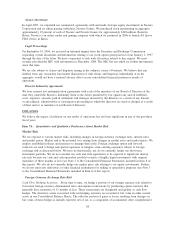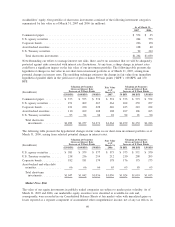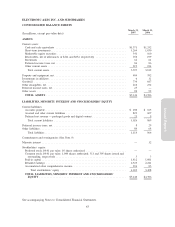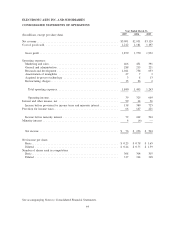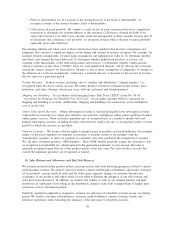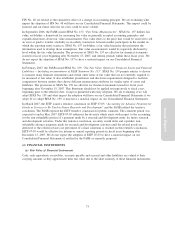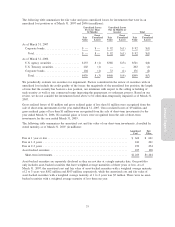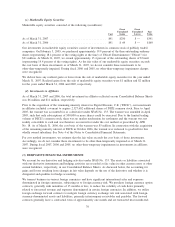Electronic Arts 2007 Annual Report Download - page 142
Download and view the complete annual report
Please find page 142 of the 2007 Electronic Arts annual report below. You can navigate through the pages in the report by either clicking on the pages listed below, or by using the keyword search tool below to find specific information within the annual report.test. These estimates generally involve complex issues and require us to make judgments, involve analysis of
historical and future trends, can require extended periods of time to resolve, and are subject to change from
period to period. In all cases, actual results could differ materially from our estimates.
(e) Cash, Cash Equivalents, Short-Term Investments, Marketable Equity Securities and Other
Investments
Cash equivalents consist of highly liquid investments with insignificant interest rate risk and original or
remaining maturities of three months or less at the time of purchase.
Short-term investments consist of securities with original or remaining maturities of greater than three months
at the time of purchase. The short-term investments are available for use in current operations or other
activities such as capital expenditures and business acquisitions.
As of March 31, 2007 and March 31, 2006, short-term investments and marketable equity securities were
classified as available-for-sale and stated at fair value based upon quoted market prices for the securities.
Unrealized gains and losses are included as a separate component of accumulated other comprehensive
income, net of any related tax effect, in stockholders’ equity. Realized gains and losses are calculated based on
the specific identification method. We recognize an impairment charge when we determine that a decline in
the fair value of a security below its cost basis is other-than-temporary.
Investments in affiliates consist of investments in equity securities accounted for under either the cost method
or the equity method in accordance with Accounting Principles Board Opinion (“APB”) No. 18, “The Equity
Method Of Accounting For Investments In Common Stock”. Our share of earnings or losses of investments in
affiliates accounted for under the equity method is included in interest and other income, net, in our
Consolidated Statement of Operations, except for investments where we are not able to exercise significant
influence over the operating and financing decisions of the investee, in which case the cost method of
accounting is used. We evaluate the investment in affiliates to determine if events or changes in circumstances
indicate an other-than-temporary impairment in value. We recognize an impairment charge when we determine
an other-than-temporary impairment in value exists.
(f) Inventories
Inventories consist of materials (including manufacturing royalties paid to console manufacturers), labor and
freight-in. Inventories are stated at the lower of cost (first-in, first-out method) or market.
(g) Property and Equipment, Net
Property and equipment, net, are stated at cost. Depreciation is calculated using the straight-line method over
the following useful lives:
Buildings ................................. 20to25years
Computer equipment and software ............... 3to5years
Furniture and equipment ...................... 3to5years
Leasehold improvements ...................... Lesser of the lease term or the estimated useful lives
of the improvements, generally 1 to 10 years
Under the provisions of American Institute of Certified Public Accountants Statement of Position (“SOP”)
98-1, “Accounting for the Costs of Computer Software Developed or Obtained for Internal Use”, we capitalize
costs associated with customized internal-use software systems that have reached the application development
stage and meet recoverability tests. Such capitalized costs include external direct costs utilized in developing
or obtaining the applications and payroll and payroll-related expenses for employees who are directly
associated with the applications. Capitalization of such costs begins when the preliminary project stage is
complete and ceases at the point in which the project is substantially complete and ready for its intended
purpose. The net book value of capitalized costs associated with internal-use software amounted to $18 million
and $23 million as of March 31, 2007 and 2006, respectively, and are being depreciated on a straight-line
basis over each asset’s estimated useful life that ranges from three to five years.
68


